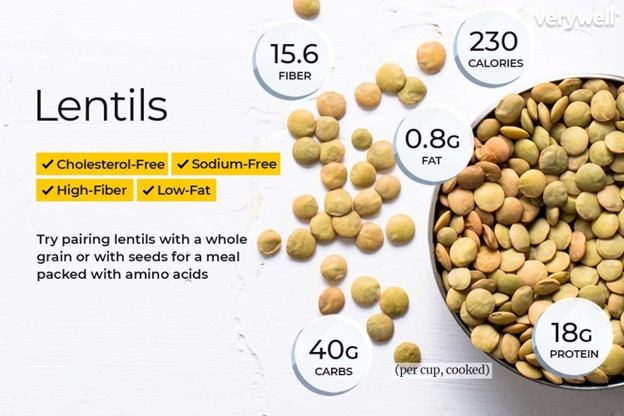A nurse is providing teaching about increasing dietary fiber to an antepartum client who reports constipation. Which of the following food selections has the highest fiber content per cup?
Lentils
Oatmeal
Cabbage
Asparagus
The Correct Answer is A
Lentils. Lentils have the highest fiber content per cup compared to the other options. One cup of cooked lentils provides approximately 15.6 grams of fiber. Oatmeal provides approximately 4 grams of fiber per cup, asparagus provides approximately 3.6 grams of fiber per cup, and cabbage provides approximately 2.6 grams of fiber per cup. Increasing dietary fiber is an effective way to manage constipation during pregnancy, as it can promote bowel regularity and prevent complications such as hemorrhoids. The nurse can provide additional education on other high-fiber food options, the importance of drinking adequate fluids, and the need to increase physical activity to help manage constipation. 
Nursing Test Bank
Naxlex Comprehensive Predictor Exams
Related Questions
Correct Answer is C
Explanation
Choice A rationale:
Blood pressure of 136/88 mm Hg should be monitored, but it is not a finding that the nurse needs to urgently report to the provider following the administration of butorphanol. The blood pressure reading is slightly elevated but might be attributed to pain or anxiety during labor.
Choice B rationale:
Moderate fetal heart rate variability is a reassuring sign of fetal well-being and is an expected finding during labor. It does not require immediate reporting to the provider.
Choice C rationale:
C. Respiratory rate 100/min: A respiratory rate of 100/min is indicative of tachypnea, which could suggest maternal distress, hypoxemia, or an adverse reaction to the medication. While opioids typically depress respiration, this finding is abnormal and warrants immediate evaluation to rule out complications such as maternal anxiety, pain, or hypoxia.
Choice D rationale:
Urinary output of 120 mL in 2 hours is an acceptable finding during labor and does not require immediate reporting to the provider. Adequate urinary output varies, but generally, 30 mL/hour is considered acceptable during labor.
Correct Answer is B
Explanation
The correct answer is choice B. The nurse should verify that informed consent is obtained prior to administration of a dinoprostone insert to induce labor for a client. Instructing the client to avoid urinary elimination until after administration is not necessary. Allowing the medication to reach room temperature prior to administration is also not necessary. Placing the client in a semi-Fowler's position for 1 hr after administration is not necessary.
Whether you are a student looking to ace your exams or a practicing nurse seeking to enhance your expertise , our nursing education contents will empower you with the confidence and competence to make a difference in the lives of patients and become a respected leader in the healthcare field.
Visit Naxlex, invest in your future and unlock endless possibilities with our unparalleled nursing education contents today
Report Wrong Answer on the Current Question
Do you disagree with the answer? If yes, what is your expected answer? Explain.
Kindly be descriptive with the issue you are facing.
